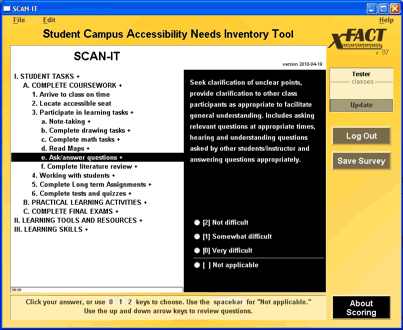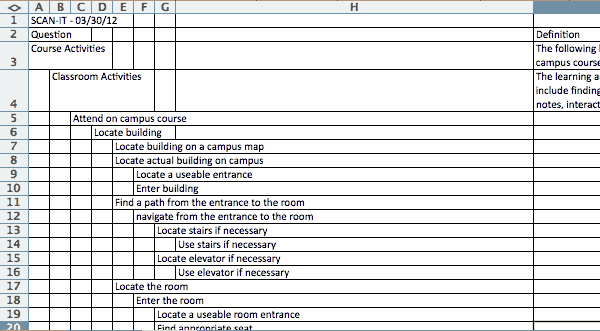The Student Campus Accessibility Needs Inventory Tool (SCAN-IT) was preceded by the Accessible Campus Environment Survey (ACES), which was developed over a period of 10 years beginning early 2000’s. In the early 2000’s, a team of graduate and undergraduate occupational therapy students and faculty developed categories and subcategories to describe all the activities that a student may engage in while on college campus. These categories were revised based on feedback from numerous advisors and information from related projects. An early version of the ACES questionnaire was released in the form of the Student Activity Accessibility Checklist, created for the University of Kansas (Smith, et al., 2002). The advisory panel of the ACCESS-ed Project at R2D2 Center continued the process of refining the taxonomy. The ACES consisted of 1139 question divided into six major categories of student activities. The six major categories encompassed a wide range of aspects of student life and included 1) common activities, 2) daily student activities, 3) learning skills, 4) weekly or occasional activities, 5) sporadic activities occurring every semester, and 6) infrequent activities occurring once a year (Smith, Hirschman, & Kastner, 2007).
The tools name was changed to SCAN-IT, as it measures campus accessibility from a student perspective, and not the campus environment itself. The SCAN-IT is an innovative web-based software data collection system designed to obtain a snapshot of the learning profile of students in a class. The SCAN-IT questions cover student occupations from obtaining materials, writing papers, studying, to interacting in group projects. The items in the survey use an activity analysis model to identify student’s problem areas based on the physical, sensory, perceptual, cognitive and social components of task performance. SCAN-IT requests students to rate the difficulty of the tasks they perform in a multiple choice format in response to the question: How difficult is this task for me? The current version of SCAN-IT taxonomy focus on three principle categories, 1) classroom activities, 2) online activities, and 3) outside of classroom activities. The three categories have approximately 350 items altogether in the current version of SCAN-IT.
Below is a screenshot of the SCAN-IT taxonomy.
Figure 5: SCAN-IT. Screenshot of the SCAN-IT taxonomy in the xFACT platform. Multiple levels, a definition, and the response set are displayed.

SCAN-IT Taxonomy

Download
Bibliography
Presentations
Smith, R. O., Hirschman, A., & Kastner, M. (2008, July 14). A student measure of campus accessibility: The ACES taxonomy. Presented at the 31st annual international AHEAD Conference, Reno, NV.
Fernandes, A., & Smith, R. O. (2011, April). Obstacles and facilitators of inclusive post-secondary education for students with disabilities: An instructor perspective. AOTA 91st Annual Conference, Philadelphia, PA.
Fernandes, A., & Smith, R. O. (2010, May). SCAN-IT: The Student Campus Accessibility Needs Inventory Tool. AOTA 90th Annual Conference, Orlando, FL.
Thesis
Kastner, M. (2009). Measuring barriers on a post-secondary campus from a student perspective using the Accessible Campus Environment Survey (ACES). Unpublished master’s thesis, University of Wisconsin-Milwaukee. Available through the University of Wisconsin-Milwaukee Library.
Fernandes, A. (2010). Effects of student needs and universal design information on increasing instructor willingness to implement inclusive course design features. Unpublished master’s thesis, University of Wisconsin- Milwaukee. Available through the University of Wisconsin-Milwaukee Library.